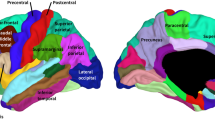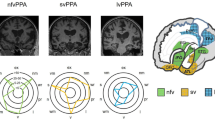Abstract
The profound language deficit in early infantile autism has led to speculation about the similarities between autistic and language-impaired children. Since aphasia in adults and many children is typically the result of left cerebral hemisphere damage, some researchers have suggested that autistic children also suffer from left hemisphere damage. So far, only indirect or unreliable evidence has been offered in support of this hypothesis. In the present experiment, autistic, language-impaired, and non-language-impaired children were compared on a dichotic listening task designed to overcome some of the deficiencies of earlier research. Language-impaired children were found to exhibit a left ear bias for language material (indicating right hemisphere lateralization for language), whereas the autistic and non-language-impaired children showed the opposite, right ear bias. As the autistic children showed a pattern similar to that of normal children, the present experiment found no evidence for either left hemisphere damage or aphasiclike performance among autistic children. The implications of these findings for understanding the autistic language deficit are explored.
Similar content being viewed by others
Reference note
Day, R. S., Cutting, J., & Copeland, P.Perception of linguistic and nonlinguistic dimensions of dichotic stimuli, Paper presented at the 12th annual meeting of the Psychonomic Society, November 1971.
References
Alajouanine, T., & Lhermitte, F. Acquired aphasia in children.Brain, 1965,88, 653–662.
Annett, M. Hand preference and the laterality of cerebral speech.Cortex, 1975,11, 305–328.
Bartak, L., Rutter, M., & Cox, A. A comparative study of infantile autism and specific developmental receptive language disorder: 1. The children.British Journal of Psychiatry, 1975,126, 127–145.
Basser, L. S. Hemiplegia of early onset and the faculty of speech with special reference to the effects of hemispherectomy.Brain, 1962,85, 427–460.
Berlin, C. I., Hughes, L. F., Lowe-Bell, S. S., & Berlin, H. L. Dichotic right ear advantage in children 5 to 13.Cortex, 1973,9, 394–401.
Blackstock, E. G. Cerebral asymmetry and the development of early infantile autism.Journal of Autism and Childhood Schizophrenia, 1978,8, 339–353.
Broadbent, D. E.Decision and stress. New York: Academic Press, 1971.
Brown, R.A first language: The early stages. Cambridge: Harvard University Press, 1973.
Bryden, M. P., & Sprott, D. A. Statistical determination of degree of laterality.Neuropsychologica, 1981,19, 571–581.
Churchill, D. W. The relation of infantile autism and early childhood schizophrenia to developmental language disorders of childhood.Journal of Autism and Childhood Schizophrenia, 1972,2, 182–197.
Colbourn, C. J. Can laterality be measured?Neuropsychologica, 1978,16, 283–289.
Colby, K. M., & Parkinson, C. Handedness in autistic children.Journal of Autism and Childhood Schizophrenia, 1977,7, 3–9.
Dennis, M., & Whitaker, H. A. Language acquisition following hemidecortication: Linguistic superiority of the left over the right hemisphere.Brain and Language, 1976,3, 404–433.
Gazzaniga, M. S., & Le Doux, J. E.The integrated mind. New York: Plenum, 1978.
Goldfarb, W.Childhood schizophrenia. Cambridge: Harvard University Press, 1961.
Hauser, S. L., De Long, G. R., & Rosman, N. P. Pneumographic findings in the infantile autistic syndrome.Brain, 1975,98, 667–688.
Hécaen, H. Acquired aphasia in children and the ontogenesis of hemispheric functional specialization.Brain and Language, 1976,3, 114–131.
Heir, D., Le May, M., & Rosenberger, P. Autism and unfavorable left-right asymmetries of the brain.Journal of Autism and Developmental Disorders, 1979,9, 153–159.
Holland, F. M., & Juhrs, P. D. An effective treatment tool with autistic children.Journal of Music Therapy, 1974,11, 1–12.
Hunt, E., Lunneborg, C., & Lewis, J. What does it mean to be high verbal?Cognitive Psychology, 1975,7, 154–221.
Kimura, D. Left-right differences in the perception of melodies.Quarterly Journal of Experimental Psychology, 1964,16, 355–358.
Kinsbourne, M. Minor hemisphere language and cerebral maturation. In E. H. Lenneberg & E. Lenneberg (Eds.),Foundations of language development (Vol. 2). London: Academic Press, 1975.
Langdell, T. Recognition of faces: An approach to the study of autism.Journal of Child Psychology and Psychiatry, 1978,3, 255–268.
Lenneberg, E. H.Biological foundations of language. New York: Wiley, 1967.
Lockyer, W., & Rutter, M. A five to fifteen year followup study of infantile psychosis: Patterns of cognitive ability.British Journal of Psychiatry, 1970,9, 152–163.
McCann, B. S. Hemispheric asymmetries and early infantile autism.Journal of Autism and Developmental Disorders, 1981,11, 401–411.
Meddis, R. Unified analysis of variance by ranks.British Journal of Mathematical and Statistical Psychology, 1980,33, 84–98.
Pohl, P. Dichotic listening in a child recovering from acquired aphasia.Brain and Language, 1979,8, 372–379.
Prior, M. R., & Bradshaw, J. L. Hemisphere functioning in autistic children.Cortex, 1979,15, 73–81.
Ramondo, N., & Schwartz, S. Diagnosing early infantile autism.Current Psychological Reviews, 1981,1, 3–16.
Rasmussen, T., & Milner, B. Clinical and surgical studies of the cerebral speech areas in man. In K. J. Zuelch, O. Creutzfeldt, & G. Galbraith (Eds.),Cerebral localization: An Otfried Foerster Symposium. Heidelberg: Springer-Verlag, 1975.
Ricks, D. M., & Wing, L. Language, communication and use of symbols. In L. Wing (Ed.),Early childhood autism. New York: Pergamon, 1976.
Rimland, B.Early infantile autism. New York: Appleton-Century-Crofts, 1964.
Rutter, M. Concepts of autism: A review of research.Journal of Child Psychology and Psychiatry and Allied Disciplines, 1968,9, 1–25.
Schwartz, S. Language disabilities in infantile autism: A brief review and comment.Applied Psycholinguistics, 1981,2, 25–31.
Schwartz, S., & Johnson, J. H.Psychopathology of childhood. New York: Pergamon, 1981.
Schwartz, S., & Wiedel, T. C. Individual differences in cognition: Relationship between verbal ability and memory for order.Intelligence, 1978,2, 353–369.
Sommers, R. K., & Taylor, M. L. Cerebral speech dominance in language-disordered and normal children.Cortex, 1972,8, 224–233.
Tager-Flusberg, H. On the nature of linguistic functioning in early infantile autism.Journal of Autism and Developmental Disorders, 1981,11, 45–55
Walsh, K. W.Neuropsychology: A clinical approach. Edinburgh: Churchill Livingstone, 1978.
Wing, J. K. Diagnosis, epidemiology, aetiology. In J. K. Wing (Ed.),Early childhood autism. London: Pergamon, 1966.
Witelson, S., & Rabinovitch, M. S. Hemispheric speech lateralization in children with auditory-linguistic deficits.Cortex, 1972,8, 412–426.
Zaidel, E. Lexical organisation in the right hemisphere. In P. A. Buser & A. Rougeul-Buser (Eds.),Cerebral correlates of conscious experience. Amsterdam: North Holland, 1978.
Author information
Authors and Affiliations
Additional information
The assistance of Mansil Robertson, Wendy Griffith, and Carol Pavey in organizing the children for this study is gratefully acknowledged. The research was supported by grants from the Educational Research and Development Committee and the Australian Research Grants Committee.
Rights and permissions
About this article
Cite this article
Arnold, G., Schwartz, S. Hemispheric lateralization of language in autistic and aphasic children. J Autism Dev Disord 13, 129–139 (1983). https://doi.org/10.1007/BF01531814
Issue Date:
DOI: https://doi.org/10.1007/BF01531814




